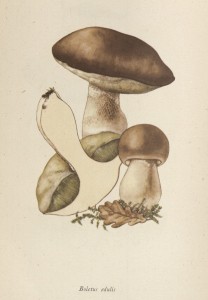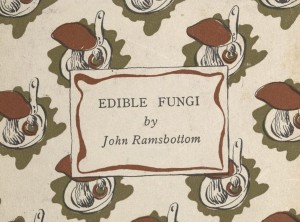This post is part of an ongoing series featuring items from the newly acquired Santo Domingo collection.
Feeling a bit peckish? Why not try a delicious dish featuring Boletus edulis, which are fleshy mushroom-like fungi which have tubes in place of gills. They are often characterized as being “spongy underneath.”

To make one version of French Crepes a la Bordelaise simply cut the caps of Boletus edulis into 1/2 inch thick slices and remove the tubes if they are soft. Season with salt and pepper and put them into boiling olive oil in a deep frying pan. Cook until golden brown, drain, and then serve with a little butter, chopped parsley, and garlic (presumably within a crepe).
Another popular edible fungi is Lactarius deliciousus or more commonly known as the Saffron Milk Cap. The cap is a brick-orange color and when it is broken the “milk” is saffron colored.
The first known illustration of a fungus is generally considered to be L. deliciousus which was preserved in a fresco in Pompeii. It is still popular in cuisine today throught Western Europe, particularly in Spain and Italy.
Edible fungi, by John Ramsbottom … With colour plates by Rose Ellenby. London, New York, [Penguin books limited] 1943. QK617 .R3.
Thanks to Alison Harris, Santo Domingo Project Manager for contributing this post.



